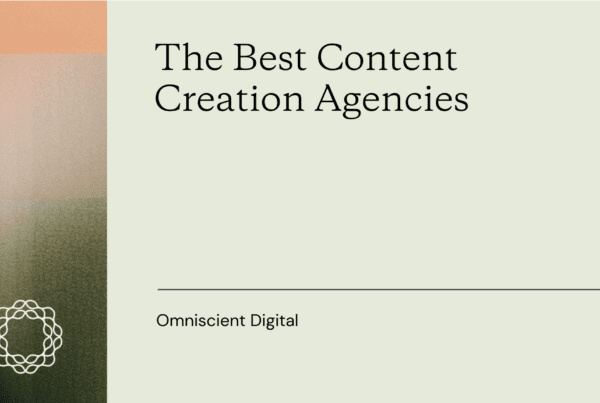
Creating original content can be time-consuming and expensive. Between topic planning, writing, optimizing, publishing, and promoting your content, it’s easy to feel overwhelmed.
On top of all this, there’s no guarantee this content will reach your target audience.
We get it—we face the same issues and challenges here at Omniscient Digital.
The good news is that, with a few simple tweaks, you can extend that initial hard work so much further and breathe new life into your best content ideas.
Today, we’re sharing our prized strategies for repurposing every piece of content for maximum possible impact.
What Is Content Repurposing?
Content repurposing is the art of transforming existing content to expand its reach. The process of repurposing or recycling content is to convert that content into a new medium, such as changing an old blog post into a video, for example.
While you can leverage content repurposing for any popular content on your site, this strategy works best for evergreen content that won’t fall out-of-date anytime soon.
Learn more about our philosophy behind content repurposing and the “Nose-to-Tail” content marketing method.
What Are the Advantages of Content Repurposing?
Content repurposing should be baked into every content marketing strategy because it ensures each idea is consumed as frequently and by the most people as possible.
Here are the top advantages for repurposing your content.
To Save Time and Costs
Content repurposing makes it easier to increase your content output without having to add additional resources.
When you repurpose your content, you no longer need to develop a brand new idea every time you want to write a blog post, build a newsletter, or record a podcast.
Recycling content means you can take one key idea or piece of content and use it as the foundation for e-books, video content, blog posts, and infographics. This ultimately makes the most of your team’s content efforts and ensures that you’re using every good content idea to its fullest potential.
Whether you’re a large or small business, content repurposing saves you time and money.
To Get in Front of Different Audiences
Do you prefer to read the news or listen to the day’s top stories? Every individual has their preferences when it comes to devouring content. Some people are more visual, and others like audio formats and online podcasts.
From a content standpoint, people who read blog posts probably have different preferences and needs from those who listen to podcasts.
Converting your content into alternative formats helps you reach and engage new audiences.
You’ll also find that different content types are better suited for different stages of the buyer’s journey. For instance, someone in the awareness stage may prefer a visual infographic, but another individual in the consideration stage might want to see a data-backed e-book. These both capture the same content idea but present it differently.
When you appeal to multiple users, you make it easier for individuals to engage with and appreciate your old and new content.
5 Ways to Repurpose Your Content
Content repurposing is an integral part of any effective content strategy. But, how do you successfully repurpose content?
Take a look at our top five suggestions for repurposing content. Note: These are suggestions based on our experience; there are countless ways to repurpose content based on your audience and promotional channels.
1. Pull Together Multiple Blog Posts into an Ebook
Do you have several blog posts that fall under the same subject? Converting a blog series into an e-book is an excellent way of re-presenting content and capturing lead information.
Instead of scrolling and clicking through your site, readers can simply download your e-book and read at their convenience.
Add some extra value to your e-book by including some exclusive in-house research or expert opinions on the topic. The promise of unique insights and data should help convince your readers to download the e-book.
2. Convert Podcasts into Blog Posts
Podcasts are at an all-time high right now. 75% of people in the U.S. are familiar with podcasting, and 37% listen monthly. This number will grow as podcasting becomes more mainstream.
People often enjoy listening to subject-matter experts discussing relevant topics; podcasts also allow you to show your brand’s unique personality.
Podcasts carry a unique advantage in that they don’t require your audience to be actively engaged and looking at a screen. In comparison, reading an article requires your audience to be giving your content their full attention. Some subscribers prefer the former, but there are several consumers who’d rather read than listen.
You can appeal to both these audiences by repurposing your podcast conversations and interviews into blog posts. Moreover, publishing your podcasts as written blog content allows you to optimize your interviews and guest conversations for search engines and specific keywords.
Here at Omniscient, we turn episodes of The Long Game into blog posts (and video!) so that no matter if you prefer to listen, watch, or read, you can enjoy our banter and expert chats.
3. Build Online Courses From Existing Content
Online courses are a popular method of learning in-depth material about a subject. But, for course creators, they’re time-consuming to build from scratch.
Luckily, you can pull together existing content as your online course’s foundation. For instance, if you are an A-level Chemistry tutor online, you can integrate existing educational resources to establish the foundation of your online course quickly and efficiently.
Educational content like how-to guides, tutorials, expert video interviews, and Q&A posts make great material for online course modules or webinars. With a bit of editing and the inclusion of interactive elements like quizzes, you can produce some informative online courses. An intro maker can be a useful tool while creating a video.
Creating online courses helps establish your business as a subject-matter authority—if you can teach your subject, you’ll be seen as an expert.
Online courses are also often a great starting point for a community. Try setting up a Slack or Facebook group for participants to chat with one another about how they’re moving through the modules. This is an excellent technique for driving brand engagement, too.
Check out the available tools to help you turn high-quality content into course modules. You could try:
Learn the exact content strategy frameworks we use to drive growth for unicorns and enterprise businesses in our online content strategy course.
4. Curate Blog Posts into a Newsletter Series
Even your top blog readers aren’t going to catch every single post you publish.
Delivering content directly to your subscribers’ inbox is an excellent way of boosting brand engagement and growing your email list. Instead of having to track down the blog posts themselves, your audience can read them at their own pace from their inbox.
Curate a newsletter or email series full of actionable tips and recommendations from your top or recently published blog posts. You could then add a CTA button directing readers to your blog to prompt users to visit your site.
5. Create Infographics to Illustrate Old Content
A well-designed infographic will appeal to your visual audience. What’s more, a data-driven infographic has the chance to be shared on social media, commented on, liked, and shared (and linked to) on other sites.
Old case studies that contain statistics and other in-house research are the best starting points for building visual infographics, as are lengthy processes that can be illustrated with icons and graphics. A long, text-based how-to guide could also be converted into a colorful and eye-catching infographic—or even a slide deck or Slideshare for LinkedIn.
Then, you can share these infographics as new posts or social media posts.
Take a look at this example of a case study transformed into an infographic:
You don’t need to have advanced graphic design skills either—there are plenty of tools out there to help you get started.
Try building infographics with one of these tried and tested tools:
For more help on what to include in your marketing toolkit, take a look at our pick of the top content marketing tools to make your life easier and content better.
3 Examples of Valuable Repurposed Content
Here are some real-world examples to help get you thinking about how you can apply these content recycling strategies across your site.
1. ProBlogger: Converting Blogs to Ebooks
ProBlogger founder Darren Rowse successfully transformed a series of blog posts into a printed and digitally available book, ProBlogger: Secrets for Blogging Your Way to a Six-Figure Income.
Rowse wanted to make it easier for readers to access the 300 to 400 articles he had already published on monetizing a blog. Despite being published in 2010, the book is still available to purchase and has been broken down into online courses, too. Rowse has since released multiple ebooks and online courses that repackage elements of his blog posts.
2. Backlinko: Breaking up Content into Different Formats
Brian Dean, the founder of Backlinko, is an expert at breaking down large pieces of content into digestible chunks suitable for social media channels and videos. For instance, Dean first published an on-page SEO guide in 2013. Several years after, he made it into a YouTube video. Despite it being 75% recycled content, the video has clocked up close to 230,000 views.
3. Moz: Turning Videos into Actionable Blog Posts
Moz’s popular Whiteboard Friday videos provide marketers with SEO guidance and actionable tips. Moz then turns these videos into blog posts with video transcriptions. While Moz is aware that some users may prefer to read the content instead of watching it, these blog posts also provide the perfect opportunity to rank in SERPs and pull in more organic traffic.
Final Thoughts
Today we’ve shared our top tips for how to reuse content, but there’s no limit to the number of ways you can creatively repurpose your existing content into something that your audience will love.
We recommend starting slow and gradually repurposing your content elements so you can see what works best for your audience.
Once you get into the habit of repurposing content, you’ll soon see how much time it saves and how it can boost audience engagement, too.



